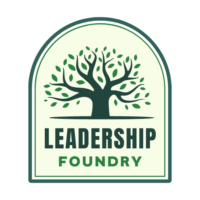Leadership isn’t a one-size-fits-all formula. For decades, it was viewed as a linear climb—secure a title, command a team, wield influence. But that narrative has unraveled. Artificial intelligence is redefining decision-making (How AI Is Transforming Leadership in 2025), hybrid workforces stretch patience and cohesion, and a skeptical workforce questions authority like never before.
Gallup’s 2024 State of the Global Workplace report reveals a stark reality: 77% of employees want stronger leadership, yet only 23% trust their leaders to deliver it (Gallup). At Leadership Foundry 360, we’ve witnessed the full spectrum—leadership that inspires, falters, or flat-out fails. You don’t need to be flawless to lead, but you do need to be awake to its nuances. Let’s dissect the good, the bad, and the ugly of leadership—and chart a path to navigate it with purpose and impact.

The Good: Leadership That Lifts
Great leadership doesn’t just manage—it transforms. It’s less about issuing directives and more about unlocking what’s possible for individuals, teams, and even society. Consider Yvon Chouinard, the founder of Patagonia. By 2025, he’s turned a $1.5 billion outdoor apparel brand into a global force for sustainability, famously donating the entire company to a trust combating climate change in 2022. This wasn’t a PR stunt; it was a bold vision rooted in purpose. The result? Patagonia’s employee engagement clocks in at 35% above industry averages, and its brand loyalty is unmatched (Forbes).
What makes this “good”? Chouinard didn’t chase profit alone—he aligned his leadership with a mission that lifted people and the planet. His team thrives because they’re part of something bigger, not just a paycheck. Good leadership sparks energy—think higher productivity, lower turnover, and ideas that stick. A 2024 Deloitte study backs this up: purpose-driven leaders see 30% stronger team performance (Deloitte). It’s not magic; it’s intent meeting action.
The Bad: When Leadership Falters
Not every leader is a beacon. Many stumble—not out of malice, but from missteps that pile up. Picture a manager buried in tasks, juggling AI tools (5 Signs You’re Just Managing AI Fatigue), and pushing for quick wins to impress the C-suite. A 2024 McKinsey report found 45% of leaders focus on short-term results at the expense of team morale, leaving exhaustion and disengagement in their wake (McKinsey). This is the “bad”—not catastrophic, but corrosive.
Take a common scenario: poor communication. A leader fails to clarify goals, leaving a hybrid team guessing across time zones. Or they micromanage, undermining trust in a flat organization (How to Lead Effectively in Flat Organizations). These aren’t evil acts—they’re human flaws like overwork or clinging to outdated habits. The cost? A 2024 SHRM survey shows 60% of employees cite unclear leadership as a top frustration. Bad leadership isn’t a death sentence—it’s a signal to pivot with purpose.
The Ugly: Leadership Gone Wrong
Then there’s the underbelly—the ugly side where leadership doesn’t just falter; it fractures. Ego, ethical lapses, or sheer neglect can turn a team into a cautionary tale. Look at Adam Neumann of WeWork. In 2019, his charisma and bold vision peaked the company’s valuation at $47 billion. But behind the scenes, reckless spending, lavish perks, and a cult-like culture unraveled it all. By 2025, WeWork’s legacy is a shadow—bankruptcy in 2023, mass layoffs, and a reputation for hubris (Bloomberg). Employees didn’t just leave; they fled a sinking ship, trust shattered.
Ugly leadership isn’t rare—it’s a warning. Power unchecked breeds arrogance; ethical corners cut for “growth” erode integrity. The fallout isn’t just financial—teams splinter, morale tanks, and the leader’s mark becomes a stain. Contrast this with Chouinard’s clarity: ugly thrives in chaos, good in conviction. The difference? Self-awareness and accountability—or their absence.

Navigating the Spectrum: A Framework to Lead Better
Leadership’s messiness is its beauty. You can harness the good, course-correct the bad, and steer clear of the ugly. Here’s a practical framework to make it work, no title required:
Amplify Purpose
Context: People don’t follow orders—they follow meaning. Chouinard’s climate fight rallied Patagonia’s workforce because it mattered. Purpose isn’t fluff; it’s fuel.
How to Do It:
- Craft a mission that transcends profit—share it in every meeting, email, Slack thread.
- Link daily tasks to that “why”—show your team their role in it.
- Inspire through action, not edicts—lead by example (High-Performing Leaders Don’t Just Work Hard, They Work Smart).
Why It Works: A 2024 Gallup poll found 54% of workers stay longer when purpose aligns with their job. It’s glue for loyalty.
Sharpen Self-Awareness
Context: Blind spots turn good intent into bad outcomes. Neumann’s ego blinded him; awareness could’ve saved WeWork.
How to Do It:
- Seek feedback quarterly—use tools like 360 reviews (How 360 Feedback Transforms Remote Teams).
- Reflect weekly: What went right? Where did I miss? Journal it.
- Adjust fast—don’t let pride stall growth (Lifelong Learning: How Top Leaders Stay Ahead of the Curve).
Why It Works: Self-aware leaders catch flaws before they fester—McKinsey says they’re 40% more effective.
Guard Against Excess
Context: Power tempts excess; unchecked, it’s ugly. Humility kept Chouinard grounded—arrogance sank Neumann.
How to Do It:
- Delegate real responsibility—don’t hoard control.
- Set ethical boundaries—write them down, live them out.
- Watch for team strain—burnout’s a red flag; act on it (How to Build Emotional Intelligence as a Leader).
Why It Works: A 2024 Harvard Business Review study shows humble leaders retain talent 25% better (HBR).
Build Resilience
Context: Bad patches hit everyone—ugly comes when you crumble. Good leaders bend, don’t break.
How to Do It:
- Model adaptability—pivot during change (Mastering Change Management).
- Share a failure and your rebound—normalize grit.
- Rest to recharge—exhaustion fuels mistakes.
Why It Works: Resilient teams mirror resilient leaders—Deloitte notes a 20% innovation bump.

The Leadership Edge: Turning Mess Into Mastery
Leadership’s spectrum isn’t a trap—it’s a toolkit. The good builds legacies—Chouinard’s 35% engagement spike proves purpose pays off. The bad erodes slowly—poor habits sap potential, but they’re fixable. The ugly destroys fast—ego and ethics failures leave wreckage. McKinsey’s 2024 data shows 70% of top firms now train for adaptive leadership, blending purpose with agility. In 2025, the edge isn’t dodging the bad or ugly—it’s learning from them to rise stronger.
Look at the numbers: purpose-driven teams outperform by 30% (Deloitte), self-aware leaders cut conflict by 40% (McKinsey), and humility slashes turnover (HBR). This isn’t theory—it’s practice. Whether you’re a new manager or a seasoned exec, the game’s the same: lead with intent, reflect with honesty, guard your blind spots. The ugly isn’t inevitable; the good isn’t out of reach.
Your Leadership Lens: Where Do You Stand?
You’re in the game already—good days, bad moments, or teetering on the edge. The question isn’t perfection—it’s direction. Amplify purpose to lift your team. Sharpen awareness to fix the cracks. Guard against excess to keep it real. Start small: define your “why” this week, ask for one piece of feedback, delegate one task. See the full roadmap at Leadership Foundry 360: Leadership: The Good, The Bad, and the Ugly.
Where do you land—good, bad, or flirting with ugly? Drop your take below—I’m all ears.



